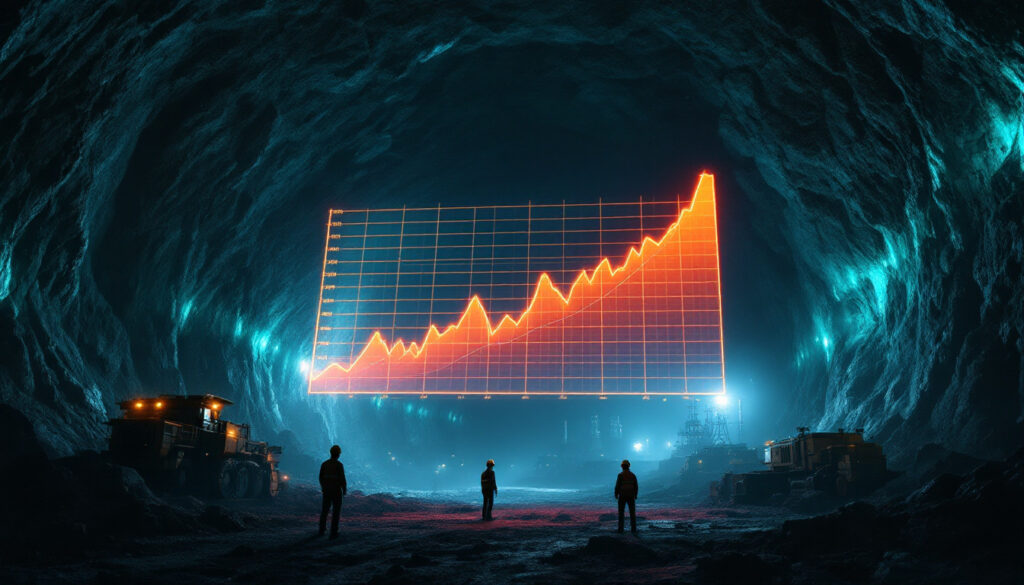Understanding the Uranium Supply Challenge
The global uranium market is facing a critical structural deficit, creating significant challenges for the nuclear energy sector. This supply-demand imbalance isn't a temporary disruption but rather a fundamental issue affecting the industry's ability to meet current and future nuclear fuel requirements. With nuclear power gaining prominence in the clean energy transition, the uranium market supply challenges have far-reaching implications for energy security and decarbonization efforts worldwide.
The supply deficit stems from years of underinvestment following the 2011 Fukushima disaster, which led to mine closures and project deferrals. Today, as nuclear energy experiences a renaissance, the industry struggles to mobilize adequate production capacity to meet even existing demand levels. This challenge is further complicated by information asymmetry in the market, with major players having visibility into contract terms and inventory levels that others lack.
What is Causing the Structural Uranium Supply Deficit?
The Reliability Gap in Industry Reporting
One of the primary challenges in understanding the uranium market is the reliability of industry reporting. The "Red Book," jointly published by the Nuclear Energy Agency and International Atomic Energy Agency, serves as the uranium industry's authoritative resource. However, it utilizes data that is already three years outdated, relying on 2021 figures to inform 2024 market decisions.
This lag creates a significant information gap, contributing to market misconceptions. Industry reports consistently overestimate production capabilities through a practice Purepoint Uranium CEO Chris Frostad describes as "stacking" – the cumulative counting of various supply sources including existing mines, restarts, and development projects as if all will achieve maximum production simultaneously.
"They start to stack up existing mines, they stack restarts, they stack development… and then on top of that, they've got proposed and planned and fairy dust and unicorns," Frostad explains, highlighting how this methodology creates artificially optimistic supply forecasts that rarely materialize.
The reality check is stark: production from existing mines is already 10-12% below what was forecast for 2024, mere months after the World Nuclear Association published its latest report. This systematic overestimation creates dangerous complacency about uranium market dynamics.
The Persistent Production Shortfall
The uranium industry faces a fundamental problem: current demand already exceeds reliable supply capabilities, even without considering additional reactor construction. The supply gap is not a future concern but a present reality.
Looking at development projects, only three "committed" uranium projects were identified for production by 2026: Elkon (Russia), Imouraren (Niger), and Etango (Namibia). However, each faces significant obstacles:
- Elkon is now sanctioned and delayed due to the Russian uranium export ban
- Imouraren remains mothballed despite years of development work
- Etango lacks financing commitments and a construction start date
Even established operations consistently underperform relative to their stated capacities. Cigar Lake, one of the world's premier uranium mines, operates 10-15% below its technical report capacity. Similarly, Kazatomprom, the world's largest uranium producer, typically achieves only 75-90% of its stated production capacity.
Restart projects have delivered particularly disappointing results. MacArthur River, despite restarting in 2022, hasn't reached full capacity, while Australia's Honeymoon restart has produced only about 50,000 pounds of uranium – a fraction of its targeted output. These consistent shortfalls demonstrate that the industry's production capabilities are significantly lower than commonly reported.
How Are Rising Costs Affecting Uranium Production?
Increasing Production Costs and Technical Challenges
The economics of uranium mining market analysis have deteriorated significantly in recent years. According to industry data, the amount of uranium resources economically minable at under $60/lb is "shrinking drastically." This threshold is critical because it represents the approximate break-even point for many projects in today's operational environment.
This cost pressure stems from multiple factors. First, easily accessible deposits are being depleted, forcing miners to pursue more technically challenging resources. Second, development costs are rising across the entire project lifecycle – from exploration to production. Even in-situ recovery (ISR) operations, which typically offer better margins than conventional mining, face increasing technical hurdles as the industry moves toward more complex deposits.
One telling example is Paladin Energy's Langer Heinrich mine in Namibia. Once considered a model operation, the project dramatically underperformed expectations, with production targets cut from 6 million pounds to 3 million before operations were suspended entirely. This pattern repeats across numerous projects, demonstrating how technical challenges consistently outpace industry projections.
The Price-Production Paradox
Despite clear supply constraints, uranium prices have not responded as fundamentals would suggest. The current spot price hovers around $60/lb with term contract prices at approximately $80/lb. While these represent significant increases from the market lows of 2016-2020, they appear insufficient to incentivize development of many projects.
Deep Yellow's Tumas project, Bannerman Resources' Etango, and Global Atomic's Dasa all require significantly higher sustained prices to achieve financing and development milestones. As Frostad notes: "It's not a price that has any contingency built into it… you've got to be able to withstand some movement in that price before you're going to turn a mine on."
This price-production paradox is exacerbated by information asymmetry in the market. Major players, including utilities and established producers, have visibility into contract terms and inventory levels that other market participants lack. This creates disconnect between public market signals and actual uranium availability, further complicating uranium investment opportunities.
Which Companies Are Best Positioned in the Current Market?
Strategic Positioning Across the Uranium Landscape
In the challenging uranium market environment, established producers with existing production and strong balance sheets maintain significant advantages. Cameco, Kazatomprom, and Orano stand as the industry's dominant forces, collectively controlling a substantial portion of global production. These companies have weathered previous market downturns and possess the technical expertise and financial resources to navigate current challenges.
Beyond the majors, companies with "legs to get them through the next few years" can weather current market conditions while waiting for higher prices. Financial strength has become a defining competitive advantage in a sector where project development timelines frequently stretch beyond a decade.
"Until the developers start to demonstrate the technical capability of actually producing something, I think they're going to always be at risk," notes Frostad, highlighting the credibility gap facing junior companies. Development-stage projects face significant hurdles without demonstrated technical capability to produce, particularly as financing sources have become increasingly selective.
Strategic partnerships have emerged as another critical success factor. "We're working with bigger companies that have got a longer runway ahead of them," Frostad explains regarding Purepoint's approach. These partnerships provide not only financial support but also technical expertise and market access that smaller players would otherwise lack.
Geopolitical Factors Affecting the Market
The uranium market is increasingly shaped by geopolitical considerations, with resource nationalism and energy security concerns creating more domestic support for uranium development in key jurisdictions.
Projects in stable jurisdictions may benefit from increased government support, including streamlined permitting processes or financing assistance. This represents a significant shift from the post-Fukushima environment when uranium projects faced heightened regulatory scrutiny and limited political support.
"A lot of this protectionism and whatnot is not bad for the resource sector… in Canada now we're starting to see… a lot more support for the resource sector nationally," observes Frostad. This trend is particularly evident in Canada, the United States, and Australia – all jurisdictions with significant uranium resources that have historically faced various development challenges.
However, geopolitical risks can also disrupt uranium supply chains. The Russian invasion of Ukraine has complicated global nuclear fuel markets, while political instability in Niger and Mali has affected uranium operations in those countries. These disruptions further strengthen the case for diversified supply sources in stable jurisdictions.
What Does the Future Hold for Uranium Supply?
Long-Term Outlook and Investment Implications
The structural supply deficit in uranium appears to be a long-term issue rather than a short-term disruption. As Frostad emphasizes: "This isn't a buyer or sellers market… even if we add another reactor, this isn't a demand problem or demand story, it's a supply story." The current situation reflects fundamental constraints on uranium production that cannot be quickly resolved.
Perhaps most concerning is Frostad's assessment that the market is "broken" and that "we can't produce the uranium that's required for where we're at right now" – suggesting that even current reactor requirements exceed reliable production capabilities. With China, India, and now Western nations pursuing nuclear expansion, this gap will only widen without significant new production.
Development timelines for new uranium projects are lengthy. NexGen Energy's Arrow project, considered one of the industry's premier development assets, could potentially take 14+ years from discovery to production. This timeline constraint means that even with higher prices, supply responses will be slow and measured.
For investors, this suggests focusing on companies with production experience, strong balance sheets, and realistic development timelines. The challenges facing the uranium industry create both risks and opportunities, with established producers likely benefiting from supply constraints in the near term.
Addressing the Supply-Demand Imbalance
New production will eventually be needed to address the structural deficit in uranium markets. Projects with clear development pathways and technical capabilities will be essential to meeting future nuclear fuel requirements. However, bringing these projects online will require sustained higher prices and potentially government support in key jurisdictions.
Government policy changes may accelerate development in some regions. Canada's Critical Minerals Strategy, for example, specifically identifies uranium as a strategic resource, potentially streamlining regulatory processes for new projects. Similar initiatives in the United States and Australia could support domestic uranium production after years of decline.
The disconnect between uranium market fundamentals and pricing suggests potential for significant price movement when market recognition occurs. As utilities deplete inventories and secondary supplies diminish, direct exposure to primary uranium production will become increasingly important.
"We don't get access and really see the economics of what is going on on the ground between the utilities, between the producers," notes Frostad. This information asymmetry creates market inefficiencies that may ultimately resolve through price discovery – potentially creating substantial opportunities for companies positioned to benefit from 2024 uranium market trends.
FAQ About the Uranium Supply Challenge
Why hasn't the uranium price responded more strongly to supply constraints?
The uranium market has unique characteristics that can delay price responses, including long-term contracts, strategic inventories, and information asymmetry between major players and the broader market. Utilities and producers have visibility into contract terms and inventory levels that other market participants lack, creating a disconnect between published prices and market fundamentals. Additionally, many utilities secured long-term contracts during previous market lows, temporarily insulating them from immediate supply pressures.
How long does it typically take to bring a new uranium mine into production?
The timeline from discovery to production can be extremely lengthy, potentially 14+ years for projects like NexGen's Arrow deposit. This includes exploration, resource definition, permitting, financing, construction, and commissioning phases, all of which face increasing complexity and costs. Even for brownfield expansions or restarts, timelines frequently extend beyond five years due to regulatory requirements, technical challenges, and financing constraints. This extended development cycle creates significant lag in the market's ability to respond to higher prices.
Which uranium supply sources are most reliable in the current market?
Existing operations from established producers with strong balance sheets (Cameco, Kazatomprom, and Orano) represent the most reliable supply sources. Restart projects and new developments have consistently underperformed relative to projections, making them less dependable for near-term supply. Secondary sources, including government inventories and underfeeding from enrichment facilities, have historically provided significant supply flexibility but are increasingly depleted. ISR operations generally offer more reliable production profiles than conventional mines but face their own technical challenges in complex geological settings.
What role does government policy play in addressing uranium supply challenges?
Government policy is increasingly important as resource nationalism and energy security concerns grow. Support for domestic resource development, including streamlined permitting and potential financing assistance, could accelerate project development in stable jurisdictions. Export controls, sanctions, and strategic inventory management also significantly impact uranium markets. The Russian invasion of Ukraine has accelerated Western efforts to secure non-Russian uranium supplies, creating opportunities for projects in allied nations. Tax incentives, production credits, and research support for advanced nuclear technologies can also influence uranium demand and pricing.
How do technical challenges affect uranium production capabilities?
Technical challenges are prevalent across the industry, affecting both conventional mining and in-situ recovery operations. These challenges have contributed to consistent underperformance relative to stated capacities, with operations typically achieving only 75-90% of projected output. Declining ore grades at mature deposits require processing more material for the same uranium output, increasing costs and lowering production efficiency. Water management, acid consumption, and ore variability create additional complexities that frequently result in production shortfalls. Addressing these technical challenges requires significant expertise and capital investment, creating barriers to entry for new producers.
Looking for an Edge in ASX Mining Investments?
Discover significant mineral announcements the moment they happen with Discovery Alert's proprietary Discovery IQ model, providing you with actionable insights before the wider market. Explore our dedicated discoveries page to see how major mineral finds have historically delivered substantial returns for early investors.




